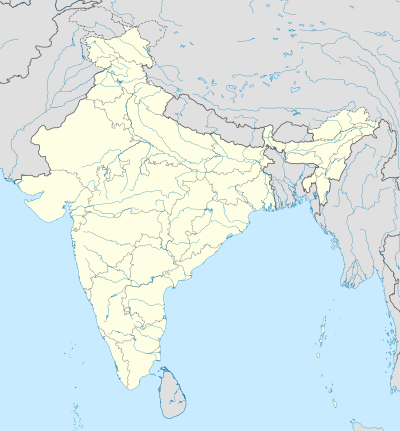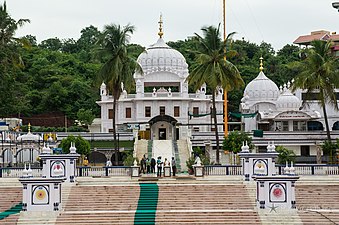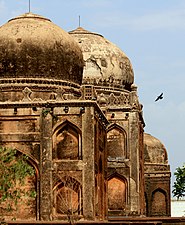|
Bidar
Bidar ( Kannada: [biːd̪əɾ] ) is a city and headquarters of the Bidar district in Karnataka state of India. Bidar is a prominent place on the archaeological map of India, it is well known for architectural, historical religious and rich heritage sites. Picturesquely perched on the Deccan plateau, the Bidar fort is more than 500 years old and still standing strong.[5] According to the book "Bidar Heritage" published by the state Department of Archaeology, Museums and Heritage, of the 61 monuments listed by the department, about 30 are tombs located in and around Bidar city.,[6] explaining its nickname, "City of Whispering Monuments". The heritage sites in and around Bidar have become the major attraction for film shooting in recent years, with Bollywood making visits apart from Kannada film industry[7] Bidar is home for the second biggest Indian Air Force training centre in the country. The IAF Station Bidar is used for advanced jet training of prospective fighter pilots on BAe Hawk aircraft.[8] Bidar city is known for its Bidri handicraft products, and its rich history. Bidar is also considered one of the holiest place for Sikh pilgrimage. Unlike other places in the region, Bidar is the coldest and wettest place in north Karnataka. For the year 2009–10, Bidar was ranked 22nd among the cleanest cities in India, and 5th cleanest in Karnataka.[9] SH4 passes through Bidar and the whole city is integrated with 4 lane road. EtymologyThe name Bidar appears to be derived from Kannada word ‘bidiru’, which means bamboo.[10] It was also referred as Bhadrakot.[11] Legend has associated Bidar with the ancient kingdom of Vidarbha, to which references are found in early Hindu literature like Malavikagnimitra, Mahabharata, the Harivamsa, Bhagavata, and a few other Puranas.[12]: 3 Its association can be seen apparently on account of the similarity in names Bidar and Vidarbha. This has been mentioned in Firishta's writings. The traditional tales reveal that Vidura lived here; hence the place was earlier called Viduranagara and also as the place where Nala and Damayanti (Daughter of Raja Bhima, the King of Vidharba) were meeting.[13] Bidar under the rule of the Bahmani Sultanate was known as Muhammadabad. HistoryThe recorded History of the city goes back to the third century B.C. when it was a part of the Mauryan Empire. After the Mauryas, Satavahanas, Kadamba and Chalukyas of Badami and later the Rashtrakutas reigned over Bidar territory. The Chalukyas of Kalyana and Kalachuris of Kalyanis also regained the area. For a short period after Kalyani Chalukyas the area of Bidar was under the rule of Seunas of Devagiri and Kakatiyas of Warangal. Bahmani SultanateThe Delhi Sultanate invaded the area first by Allauddin Khilji, and later, Muhammed-bin-Tughluq took control of entire Deccan including Bidar. In the middle of the 14th century, the Sultan of Delhi's officers that were stationed in Deccan rebelled and this resulted in the establishment of Bahmanid Dynasty in 1347 A.D. at Gulbarga/Hasanabad (present Kalaburagi). There was frequent warfare between the Bahmanids and the Vijaynagar Kingdom.[14] The history of the present fort at Bidar is attributed to the sultan Ahmed Shah Wali Bahmani, the sultan of the Bahmani dynasty till 1427, when he shifted his capital from Gulbarga to Bidar since it had better climatic conditions and was also a fertile and fruit-bearing land. The earliest recorded history of its existence as a small and strong fort is also traced to prince Ulugh Khan in 1322, whereafter it came under the reign of the Tughlaq dynasty.[15] With the establishment of the Bahmanid dynasty (1347), Bidar was occupied by Sultan Ala-ud-Din Bahman Shah Bahmani. During the rule of Ahmad Shah I (1422–1486), Bidar was made the capital city of Bahmani Kingdom.[16][17] The old fort was rebuilt and madrasas, mosques, palaces, and gardens were raised. Mahmud Gawan, who became the prime minister in 1466, was a notable figure in the history of Bidar. Bidar remained under the Barid Shahi dynasty until conquest by the Bijapur Sultanate in 1619. Aurangzeb came to Bidar after his father, Padshah (emperor) Shah Jahan, appointed him the Prince of Deccan. He wrested the Bidar Fort from the Adil Shahis after a 21-day war in 1656. With this, Bidar became a part of the Mughal dynasty for the second time.[18][19] Bidar was made a subah (imperial top-level province) in 1656, which Telangana Subah was merged into the next year.[20] In 1724, Bidar became a part of the Asaf Jahi Kingdom of the Nizams. Third son of Asaf jah l ( Nizam l ) Mir Sa'id Muhammad Khan, Salabat Jang ruled from Bidar fort from 1751 to 1762, till his brother Mir Nizam Ali Khan Asaf Jah III imprisoned him in this fort, and was killed in Bidar fort on 16 September 1763. Mohammedabad old name of Bidar is also on his name. It was connected to Hyderabad by rail in the early 20th century.[21] After India's independence, in 1956 all Kannada speaking areas were merged to form the Mysore State and Bidar became part of the new Mysore (now Karnataka) state.[19][22][23] Karez SystemAncient Karez System in the city have been recently discovered. The Karez (Qanat) is an underground network of aqueducts for water supply. The Bidar Karez, built in the 15th century, is more than 3 km (1.9 mi) long with 21 air vents.[24] Underground canals, built to connect underground water streams, were meant to provide drinking water to civilian settlements and the garrison inside the Bidar fort. This was necessary in a city where the soil was rocky and drilling wells was difficult.[25] The Bidar karez systems, believed to be the earliest ones in India, were constructed during the Bahmani period. According to Gulam Yazdani's documentation, Bidar has three karez systems: Naubad, Shukla Theerth, and Jamna Mori. Among these, Shukla Theerth stands out as the longest karez system in Bidar. The origin well of this karez was found near Gornalli Kere, a historic embankment. Jamna Mori, on the other hand, primarily served as a distribution system within the old city, with numerous channels intersecting the city streets.[26] Restoration efforts began in 2014, focusing on the desilting and excavation of the Naubad Karez.[27] In 2015, this initiative led to the discovery of 27 vertical shafts connected to the Karez. The rejuvenation of these systems has had a significant positive impact on Bidar, a city facing water scarcity. Additionally, in 2016, during a sewage line excavation, a seventh line of the system was uncovered.[28] GeographyBidar is located at 17°54′N 77°30′E / 17.9°N 77.5°E,[29] lies at a central position in Deccan, a plateau at an elevation of 2300 ft from the sea level. It has common boundaries with Maharashtra and Telangana which is, with the districts of Nizamabad and Medak in Telangana on the East and the districts of Latur, Nanded and Osmanabad in Maharashtra on the west. On the south lies the district Gulbarga of Karnataka.[30] Geology The upper crust of the plateau is of laterite, a soft porous rock with limonitic surface. This crust varies in depth from 100 ft (30 m) to 500 ft (150 m) and rests on a bed of trap, which is of much harder texture and less pervious to water. The volume of water filtered during the monsoons through the laterite stratum is arrested by the trappean bed, and a nursery of springs is formed whose natural level of effluence is the line of contact of the two strata along the base of the cliffs of the plateau. The water in course of time frets out for itself an orifice and macerates and loosens portions of its rocky channel till a rift is produced. The rift gradually dilates into a ravine, and the ravine expands into a vale. The Karez System is built along a geological fracture. Such fractures are formed at the intersection of laterite and basalt rocks and form lineaments or springs that yield water.[31] SoilBidar soils are deep (>100 cm), well-drained gravelly red clayey soils developed on plateaus of laterites. They are slightly acid to neutral (pH 6.6) in reaction with low cation exchange capacity. They are highly gravelly soils with gravel content (60 to 10%) that decrease with depth.[32] ClimateThe winter season is from November to middle of February. Bidar is one of the coldest cities (by southern standards) in Karnataka as the minimum temperature during winter nights regularly hovers around 11-12 during December, which is the coldest month with mean daily maximum temperature of 27.3 C and mean daily minimum of 13.4 C. From the middle of the February, both day and night temperatures begin to rise rapidly. May is the hottest month with mean daily maximum temperature of 38.8 C and mean daily minimum of 25.9 C. With the withdrawal of southwest monsoon in the first week of October, there is slight increase in day temperature but night temperature decreases steadily. After October, both day and night temperatures decreases progressively. The highest maximum temperature recorded at Bidar was on 8-5-1931(43.3-degree C) and the lowest minimum was on 5-1-1901(2.9-degree C, the lowest temperature ever recorded in Karnataka).[33] Present day Bidar covers an expanse of 5448 square kilometres of land and lies between 17°35' and 18°25' North latitudes and 76°42' and 77°39' east longitudes.
DemographicsAt the time of the 2011 census, Bidar had a population of 216,020. Bidar city has a sex ratio of 938 females to males and a literacy rate of 85.90%. Scheduled Castes and Scheduled Tribes made up 14.11% and 4.73% of the population respectively.[38] At the time of the 2011 census, 52.23% of the population spoke Kannada, 33.32% Urdu, 5.54% Marathi, 3.67% Hindi and 3.33% Telugu as their first language.[39] EconomyOnce a home to many cottage industries, such as cotton and oil-ginning mills,[40] there are now few industries that draw on local raw materials or skills. Even the well known form of local articrafts, bidri ware, is in a state of decline. Increasing prices of materials, especially silver, and declining sales have meant that many of the hereditary artisans are no longer employed in the production of such ware.[41] Bidar city has a large industrial area known as Kolhar industrial area.[42][43] TourismDistance from major Metropolitan cities near to Bidar. Bidar is symbolically described as City of Whispering Monuments.[44] The mountaintop city that served as the capital of medieval Deccan, has 98 monuments of which four national monuments are protected by the Archaeological Survey of India and 14 by the State Archaeology Department, Karnataka. Bidar earned a place on the World Monument Watchlist 2014.[45] Of the 741 proposals received from 166 countries, 67 sites from 41 countries were finally selected which were announced by WMF president Bonnie Burnham in New York on 8 October 2013.[46] Along with "the historic city of Bidar", two other sites in India to figure in the list were the house of Sheikh Salim Chisti in Fatehpur Sikri and Juna Mahal in Rajasthan. The WMF in its current watch site for "the historic city of Bidar" says ″challenges to the site include a lack of integrated conservation and maintenance, environmental pollution, and the construction of new developments and roadways that encroach on the historic fabric. Current land use regulations also threaten the economic livelihood of many of the city's residents, and it is hoped that revised, context-specific planning policies would both protect Bidar's historic assets while also supporting the future of its local population. It is hoped that Watch-listing will spur documentation and analysis of the city's conditions, followed by policy development and applied conservation interventions that will reveal and maintain Bidar's rich heritage, as well as support a robust and sustainable tourist industry.″[47] Mahmud Gawan MadrasaThis grandiose madrasa was built by the prime-minister of the Bahmani empire, Mahmud Gawan in the late 15th century. Its only the most imposing building of the Bahmani period, but in its plan and in the general style of its architecture it is a unique monument of its kind in India. The Madrasa, a multi-disciplinary university he set up, which had a library of around 3,000 valuable manuscripts, was severely damaged when gunpowder stored inside the rooms went off during a 27-day siege of the city by Mughal king Aurangazeb in 1656. The Mahmud Gawan Madrasa is protected by the Archaeological Survey of India.[48] Bidar FortBidar Fort is considered one of the most formidable forts of the country. Bidar city was distinctly planned and built. The main citadel complex housed the royal places. Mahals and Mosque. Adjoining to this on the southern side, the city was built for the people. Both the citadel complex and city had separate forts for protection the plan of the Bidar city fortification is pentagonal. There are five gateways for entry into the city fort. It is main citadel complex fort which is stronger. It is built on the brink of the plateau. Engineers and architecture of various countries were employed on its design and construction. A Museum is preset there having old armor, old sculptures. including many of the ancient stones,[49][50][51][52] 
Other monumentsApart from the fort Bidar houses several historical structures consisting of a couple of tomb complexes, a madrasa, a tower and a few gateways along with the fortification wall topped with battlements.[57]
Religious placesGurudwara Nanak Jhira Saheb is known to be one of Holiest Place For Sikh Devotees in India and is believed that first Sikh Guru Shri Guru Nanak Dev ji visited the place during famine in this region.[63] Art Bidri waresBidriware, one of the rarest and most intricate art forms is now unique to the city.[64] This native art form has obtained Geographical Indications (GI) registry.[65] The various art forms created by artists from Bidar city centuries ago are now major attractions in museums such as Victoria and Albert Museum, London, the National Museum in New Delhi and Indian Museum in Kolkata.[64] The Karnataka tableau at the 2011 Republic Day Parade at Rajpath in New Delhi featured Bidriware and Bidri artisans from Bidar. Rehaman Patel did an extensive research in Bidri Art from Gulbarga University. His book in Kannada version (2012) and English version (2017) also published on Bidri Art. All the dignitaries & guests of XIX Commonwealth Games 2010 were presented with mementos hand crafted in Bidri art. This art form is the Union government's choice for souvenirs at the World Economic Forum in Davos. The Kingfisher company owner Vijay Mallya has a bidri dining table with floral designs made of nearly 3.5 kg silver.[66] Transport RailBidar has connectivity with Bangalore, Hyderabad, Sainagar Shirdi, Parbhani Jn, Aurangabad, Latur, Nanded, Manmad, Mumbai, Visakhapatnam, Machilipatnam, Vijayawada and Renigunta (according to railway budget 2014–15) Construction of the Gulbarga-Bidar link is completed which was inaugurated by Prime Minister Narendra Modi.[67][68] Bidar-Hyderabad inter-city train service became operative in September 2012.[69] A Bidar-Yeshwantpur (Daily) express train[70] and Bidar-LTT Mumbai express train[71] service has been started recently. Another train starting from Bidar through Latur to Mumbai started, which runs on Thursday, Saturday and Sunday. AirBidar Airport, also known as Bidar Air Force Station, (IATA: IXX, ICAO: VOBR) is a military airbase cum Domestic Airport in Bidar, Karnataka, India.[72] The city is home to an air force station. Star Air operates 3 days a week flight between Bidar (IXX) and Bangalore (BLR). RoadFrequent KSRTC buses to Kalaburgi (Gulbarga), Hyderabad, Latur, Udgir, Nanded, Solapur. Also Volvo services to Bengaluru, Hubli, Belgavi, Davangere, Mumbai, Mangalore and Pune. Education institutions
Gallery
ReferencesCitations
Bibliography
External linksWikimedia Commons has media related to Bidar. Wikivoyage has a travel guide for Bidar.
|
||||||||||||||||||||||||||||||||||||||||||||||||||||||||||||||||||||||||||||||||||||||||||||||||||||||||||||||||||||||||||||||||||||||||||||||||||||||||||||||||||||||||||||||||||||||||||||||||||||||||||












